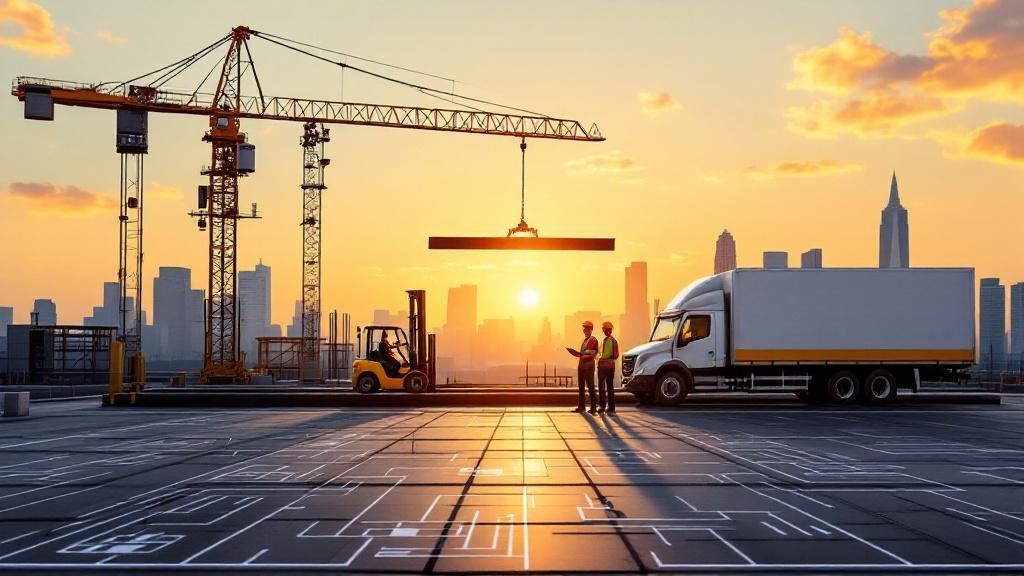Construction supply chain management is the art and science of coordinating every piece of a project puzzle—from raw materials and information to the flow of money. It’s the master plan that ensures everything, like lumber from a yard in Berkeley or custom windows for a San Francisco job, shows up on-site exactly when needed. When done right, construction supply chain management transforms the potential chaos of a build into a smooth, predictable process.
What Is Construction Supply Chain Management?
Think of a large Bay Area construction project as a complex theatrical production. Construction supply chain management (CSCM) is the director, ensuring every actor—from raw material suppliers to specialized subcontractors—hits their mark at the perfect time. It’s the system governing the entire flow of goods, data, and payments needed to get a project from a blueprint to a finished building.
This process goes far beyond logistics or scheduling a few deliveries. Real CSCM is an integrated approach that ties together everyone involved: architects, contractors, suppliers, and even the finance team. A study from Trimble highlights that digitizing this process creates a single, reliable source of information, eliminating hours of manual data entry and preventing critical details from getting lost. For builders in Oakland and San Francisco, that means fewer expensive surprises and far more control.
The Three Core Flows of a Construction Supply Chain
At its core, CSCM is about managing three distinct yet interconnected flows:
- The Product Flow: This is the physical journey of materials and equipment. It covers everything from getting foundational lumber to the job site to ensuring custom-ordered doors for a Berkeley project arrive on schedule. A smooth product flow keeps your crew working instead of waiting for a missing delivery.
- The Information Flow: This is the constant exchange of vital data—think purchase orders, delivery schedules, design specs, and progress reports. When information flows clearly, every stakeholder, from the architect in the office to the supervisor in the field, is on the same page.
- The Financial Flow: This is how money moves, including sending invoices, paying suppliers, and managing cash flow. A healthy financial flow ensures your partners get paid on time, which is key to maintaining strong relationships and keeping the project moving.
A robust supply chain is the backbone of any successful construction company. Skillful management of sourcing, ordering, and delivery prevents standing time and directly boosts profitability.
Without a solid strategy for these three flows, your projects are vulnerable to delays, budget overruns, and communication headaches. For example, a hiccup in product flow (a late lumber delivery) is often caused by a breakdown in information flow (an incorrect order date). That single mistake can create a ripple effect, stopping work on-site and straining professional relationships.
By actively managing these moving parts, contractors can shift from constantly putting out fires to proactively staying ahead of the game. You gain the power to anticipate needs, solve problems before they escalate, and deliver projects with far more consistency. Knowing your options for building material supplies in San Francisco is a critical first step for any local builder.
Pillars of a Powerful Construction Supply Chain
A resilient construction supply chain isn’t built on luck; it's built on purpose. It stands on key pillars that work together to create predictable, profitable outcomes. For builders, contractors, and architects in the Bay Area, mastering these components is what transforms potential chaos into controlled efficiency.
Think of it like framing a custom home. Every stud, joist, and beam must be placed perfectly to support the whole structure. A solid construction supply chain management system is no different—it relies on smart procurement, airtight logistics, and strong supplier relationships to hold everything together.

Image Caption: Collaboration between architects, contractors, and suppliers is the heart of effective CSCM.
This collaboration is a clear reminder that successful projects are built on a foundation of communication and shared goals among every partner.
Strategic Procurement and Sourcing for the Bay Area
Procurement isn't just about clicking "buy." It's about sourcing the right materials, at the right time, for the right price, while meeting local regulations. In a market like the Bay Area, this means sourcing for compliance with strict local codes, like California’s Title 24 energy standards.
This is where a partnership with a knowledgeable local supplier like Truitt & White pays dividends. Instead of just sending a purchase order, you can have a real conversation about project specs, explore material options, and ensure every component is up to code from the start. This proactive approach prevents costly surprises down the road.
Intelligent Logistics for Local Deliveries
Getting materials from a warehouse to your job site is a major piece of the puzzle, especially with Bay Area traffic. Intelligent logistics means more than just booking a truck; it’s about planning deliveries to sidestep peak congestion on the I-880 corridor or navigating the tight streets of San Francisco. It's about precision scheduling that minimizes crew downtime.
A well-managed supply chain delivers a serious competitive edge. According to industry data, projects with coordinated supply chains can see 20% to 30% improvements in on-time delivery and budget adherence.
Effective logistics also means choosing the right delivery model. While just-in-time (JIT) delivery reduces on-site clutter, it can be risky if a delay occurs. Many successful builders use a hybrid model: secure critical, long-lead items early and schedule other materials for JIT delivery.
Supplier Relationship Management
Your suppliers are more than just vendors; they are partners in your project's success. Building strong, collaborative relationships based on trust and open communication is a cornerstone of effective CSCM. A reliable supplier who understands your business can offer better terms, prioritize your orders, and bring solutions to the table when problems arise.
A strong CSCM system depends on relationships with diverse partners, including specialized manufacturing and industrial suppliers. For a local contractor, this means nurturing ties with a dependable "Berkeley building materials" supplier like Truitt & White, which offers invaluable insights into material availability and lead times. A true partner is invested in helping you solve problems, not just selling products.
You can learn more by reading our guide on choosing durable materials for your contracting projects.
Core Components of a Modern CSCM Strategy
| Component | Primary Goal | Benefit for Bay Area Builders |
|---|---|---|
| Strategic Procurement | Acquire the right materials at the best value while ensuring compliance. | Ensures materials meet local codes (e.g., Title 24), avoiding costly rework and project delays. |
| Intelligent Logistics | Deliver materials to the job site precisely when needed to minimize downtime. | Navigates Bay Area traffic and tight site constraints, keeping crews productive and on schedule. |
| Supplier Relationships | Build collaborative partnerships based on trust and mutual benefit. | Gains priority access to materials, better pricing, and proactive problem-solving from local experts. |
By mastering these pillars, Bay Area builders can turn their supply chain from a necessary evil into a powerful asset.
Overcoming Modern Supply Chain Challenges
In today's construction world, the supply chain is constantly being tested. For builders and contractors in the Bay Area, these aren't just abstract headlines—they’re real-world hurdles that cause project delays and budget overruns. From material shortages to price hikes, a solid construction supply chain management strategy is essential for survival.
The real shift happens when you move from a reactive to a proactive mindset. Instead of just putting out fires, the goal is to build a system that can anticipate disruptions and absorb the shock. This approach turns challenges into a competitive advantage through smarter planning.
Building Resilience Against Market Volatility
One of the toughest challenges has been the volatility in material availability and cost. Global events can send the price of essentials like lumber or steel on a rollercoaster, making it incredibly difficult to create an accurate bid. At the same time, delivery schedules have become frustratingly unpredictable.
Recent industry analysis reveals that delivery times for some raw materials have stretched significantly, a massive jump from just a few years ago. These supply chain hiccups can cost companies up to 8% of their annual revenue, highlighting the urgent need for better risk management.
A resilient supply chain is one that bends without breaking. The goal isn't to avoid all disruptions—which is impossible—but to have the flexibility to adapt quickly when they inevitably occur.
To combat this, savvy Bay Area contractors are diversifying their supplier base. Rather than relying on a single source for a critical material, they build relationships with several suppliers. This simple strategy provides a backup plan if one supplier faces a shortage, keeping the project on track.
Navigating Local Bay Area Pressures
On top of global issues, builders in Berkeley, Oakland, and San Francisco face unique local pressures. Strict seismic codes and ambitious green building goals, such as California's Title 24 and CalGreen standards, heavily influence material selection. These regulations are vital for safety and the environment but add complexity to sourcing.
Here are a few strategies to manage these local factors:
- Flexible Contracting: Build clauses into contracts that allow for potential material price increases or substitutions to protect both you and your client.
- Early Material Lock-in: For items with long lead times or unstable pricing—like custom windows or specialized engineered wood—lock in prices and place orders as early as possible.
- Local Supplier Collaboration: This is where working with a knowledgeable local supplier like Truitt & White becomes invaluable. Our team understands the specific code requirements for projects across the Bay Area and can help you proactively source compliant materials.
To buffer your projects from disruptions, it's critical to be implementing robust risk management frameworks that make this forward-thinking planning a standard procedure.
Turning Challenges into Competitive Advantages
Viewing these challenges from the right angle can reveal opportunities. California’s tough building codes push builders to use higher-quality, more durable materials. A supply chain fine-tuned to source these materials efficiently can become a signature of quality for your business, attracting clients who value performance.
Likewise, mastering Bay Area logistics—from navigating Bay Bridge traffic to coordinating deliveries on cramped urban sites—is a skill that separates the pros. Effective construction supply chain management makes it all possible. For a closer look, check our overview of the construction process in San Francisco.
Using Technology to Optimize Your Supply Chain
In today's construction industry, technology is the engine driving efficiency and profit. For builders in the competitive Bay Area market, digital tools are what separate a chaotic supply chain from a proactive, well-oiled machine. This is about using smart, accessible tools to solve real-world problems on the job site.
The right tech provides a new level of control, pulling everyone—architects, suppliers, contractors—onto the same page with a single source of truth. This alignment is the bedrock of effective construction supply chain management.
Building a Digital Foundation with BIM
One of the most powerful tools is Building Information Modeling (BIM). Far more than a 3D model, BIM is an intelligent process that creates a detailed digital twin of your project, packed with data on every component.
This is a game-changer for the supply chain. BIM software can automatically generate hyper-accurate material lists, slashing the human error that leads to ordering mistakes. This information feeds directly into procurement, streamlining the entire sourcing process.

Image Caption: A centralized BIM model integrates all project data into a clear, visual format for better planning.
This integrated view lets your team spot potential clashes and plan logistics long before anyone sets foot on-site.
Real-Time Visibility and Communication Tools
Once materials are on their way, the challenge shifts to tracking. Cloud-based platforms and mobile apps have revolutionized this process, offering real-time visibility that connects the office, the supplier, and the crew.
These tools provide serious advantages:
- GPS Fleet Tracking: Know exactly where your delivery is. Is it heading from a "lumberyard near Oakland" to a job in San Francisco, or stuck in traffic? This allows crews to prep for arrival or pivot if a delay is unavoidable.
- Shared Project Management Platforms: Tools like Asana or Procore act as a central hub where everyone can access the latest plans, schedules, and change orders.
- Instant Communication: The field can communicate with the office instantly. If a crew spots an issue, they can send photos and notes directly to the project manager for faster decisions.
To push optimization further, it’s worth looking into innovative modular construction methods. This approach depends heavily on precise, tech-driven logistics and often leads to significant reductions in waste and build times.
The Future: A Connected and Sustainable Supply Chain
The evolution of the supply chain is accelerating. The global shift toward regional networks is supercharged by technologies like machine learning and blockchain that create incredible transparency. This is fundamentally changing supplier relationships and labor dynamics.
A Key Takeaway: Technology isn’t about replacing people; it’s about empowering them. By automating repetitive tasks and providing better data, these tools free up your team to focus on building high-quality projects.
For builders in the Bay Area, this also ties directly to sustainability. Technology helps track material origins, verify certifications, and document compliance with California’s environmental codes. Embracing these tools is a core part of modern https://truittandwhite.com/green-building and key to a more resilient, transparent, and profitable business.
On-the-Ground Tips for Bay Area Builders

Image Caption: Experienced builders apply CSCM strategies directly on their Bay Area job sites for smoother project execution.
It's one thing to read about construction supply chain management, but another to make it work on a hectic Bay Area job site. Success lies in adapting these ideas to our region’s specific hurdles, from tangled regulations to hyperlocal logistics.
Think of these as field-tested strategies you can start using right away. Adopting them will help you build a more resilient and profitable business.
Forge Real Partnerships with Your Local Suppliers
Here in the Bay Area, your relationship with a supplier like Truitt & White should be a genuine partnership. A good local supplier is your first call when you're trying to head off material shortages, avoid compliance headaches, or solve a tricky delivery puzzle. They have street-level insights a national chain just can't offer.
Don't just email purchase orders. Talk to your supplier reps regularly about your project pipeline. Giving them a heads-up allows them to reserve stock for you or suggest smart alternatives before a shortage can derail your schedule.
A proactive partnership with your supplier is invaluable. They can alert you to upcoming price increases or material lead time changes, giving you the critical window needed to adjust your project plans and protect your budget.
Master the Art of Hyperlocal Logistics
Anyone who's tried to get a delivery across the Bay Bridge during commute hours knows our logistics are a different beast. For construction supply chain management to work here, you have to think block by block, not just city by city.
- Plan Around Local Events: A festival in Golden Gate Park or a game day can bring neighborhoods to a standstill. Always check local calendars when scheduling important deliveries in San Francisco or Oakland.
- Use Off-Peak Delivery Windows: Find suppliers who offer early morning or flexible deliveries. A drop-off before the morning rush can save your crew hours of waiting.
- Know Your Site’s Limits: Many job sites, especially in dense areas like Berkeley, have tight street access. Coordinate with your supplier on truck size and placement to ensure the drop goes off without a hitch.
Make California Code Compliance a Top Priority
California's building codes—especially Title 24 and CalGreen—are some of the toughest in the country. If you source non-compliant materials, you're looking at failed inspections and major delays. Compliance must be baked into your supply chain from day one.
Confirm that every product you specify, from "Bay Area windows and doors" to insulation, carries the right certifications for your specific city or county. A trusted local supplier is essential here, as they are experts in local rules and can guarantee you get compliant materials.
Champion Clear and Constant Communication
Clear, consistent communication is the glue that holds a project together. A communication breakdown is often the root cause of delays and mistakes.
Set up a clear system for how changes are shared. Whether it's a design tweak or an updated delivery ETA, that information needs to get to everyone it affects—fast. Using shared software or even a simple group chat can stop critical details from getting lost.
Frequently Asked Questions about Construction Supply Chain Management
Construction supply chain management can seem complex, but getting straight answers is the first step to making your projects more predictable and profitable. Here are common questions we hear from builders, architects, and remodelers in the Bay Area.
How can a small contractor benefit from formal CSCM?
Even for a small crew, an organized supply chain pays off. It prevents last-minute, frantic trips to the store and helps you manage cash flow by aligning material payments with project schedules. A simple system helps you build a network of reliable suppliers, cutting down on-the-job stress and boosting your bottom line.
Is just-in-time (JIT) delivery practical for Bay Area projects?
JIT delivery can be risky in the Bay Area due to our traffic and logistical challenges. A single delay on the freeway can leave your crew waiting for a critical delivery. A hybrid approach is often smarter: secure long-lead-time or custom items well in advance and use JIT for standard, easily sourced materials.
How does sustainability fit into my supply chain?
In California, sustainability is a core part of doing business. It involves intentionally sourcing eco-friendly materials to meet codes like CalGreen and Title 24. A well-run supply chain helps you track material origins, verify green certifications, and manage compliance documentation, turning a potential headache into a straightforward process.
What is the best first step to improve my supply chain?
Start by mapping your current process from start to finish. Identify your main suppliers, how materials are ordered, and where communication breakdowns or delays typically occur. This simple audit will highlight your biggest pain points, allowing you to focus on fixing one or two key issues for immediate improvement.
How do I choose the right suppliers for my projects?
Look beyond the price list. The best partners are known for reliability, deep product knowledge, and solid communication. In the Bay Area, a supplier who understands local building codes, logistical quirks, and material availability is priceless, as they can help you sidestep costly delays.
For more answers to common building questions, check out our company FAQ page.
At Truitt & White, we're more than a supplier—we're your partner in building excellence. Visit our Berkeley showroom for expert advice. Ready to streamline your next project? Contact our team of experts for personalized guidance on dialing in your supply chain.









